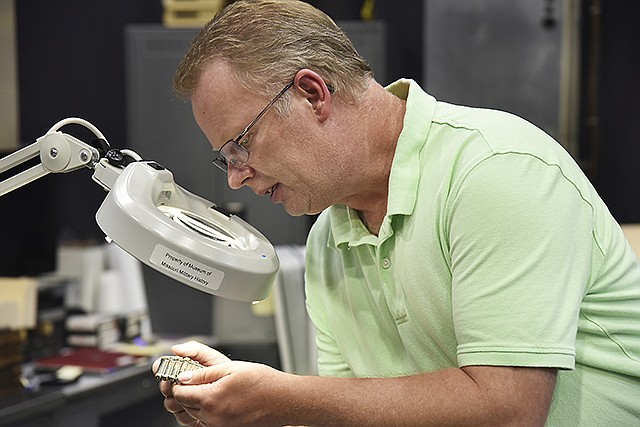Rows of military jackets, stacks of various patches, piles of buttons and boxes of miscellaneous items fill most of the processing space at the Museum of Missouri Military History.
More than 800 items have come to the newly expanded museum from the National Military Heritage Museum in St. Joseph, which recently closed. The private museum operated for about 30 years.
"Without our new facility, we could not have done this," Curator Charles Machon said.
He and volunteer assistant Doug Sheley spent six days on the road, searching through the former museum's holdings to find items to augment MMMH's existing collection.
In particular, Machon is happy to find addition military artifacts related to women, chaplains and World War I.
A majority of the St. Joseph museum's World War I items went to the Gen. John J. Pershing Boyhood Home State Historic Site, Machon said.
However, with the anniversary of World War I next year, the two facilities have agreed to share artifacts, he said.
Currently, Machon, Sheley and other volunteers are sorting and cataloging each piece.
So far, they have found service uniforms from each branch of service, including a U.S. Marine Corps maternity top and embroidery work with gold bullion thread. They also received cadet uniforms from West Point, Mexico, Wentworth and Kempker military academies.
Machon said he is pleased most of the items belonged to Missouri soldiers, helping better tell their story.
"Some have names and we can look up their World War II records," he said.
With so many pieces of clothing - a requirement of the St. Joseph museum to take all or nothing of certain collections - Machon said some of the excess will go into the museum for children to play dress up.
There are books, maps, flags and other odds and ends.
Some of the most unique items include a pressurized coffee thermos used by World War II bomber crews, a suitcase made of Pacific-theater aircraft aluminum and a housewife's kit.
"What might these items have seen," Machon wondered.
The most unexpected find was a syringe kit. It took some tinkering and wondering for them to figure out how to open it. And when they did, they found that it was not entirely empty.
The syringe kit will help the museum better tell the story of the evolution of military medicine, Sheley said.
Similarly, the variety of uniforms shows the progression of styles among the different branches, he said.
Not all of the items were from American servicemembers. Sometimes they exchanged patches or items with allies, which came home with them.
Other items are from those who were the enemy of the American soldiers at the time. This shows what they may have encountered in the field, Machon said.
"These things really help to tell the story," he said.
Many of the pieces require hours of research to identify what it is used for or what era it is from or who might have owned it.
The research is Machon's favorite part.
"I dig that stuff," Sheley agreed. "It's fun to know you didn't know everything."
Sheley, who lives in Fulton, has been researching military aircraft and insignia since he was a child.
The variety of patches, how they changed or the different materials used, and how they were sewn on can help tell a soldier's story. That has been Sheley's favorite part.
"It's awesome to get to handle this stuff," Sheley said.
It may be may be spring before patrons start to see these pieces emerge in the museum.
More than 10,000 visitors have viewed the museum in the year and a half since it relocated to its current location at the Ike Skelton Training Site.

